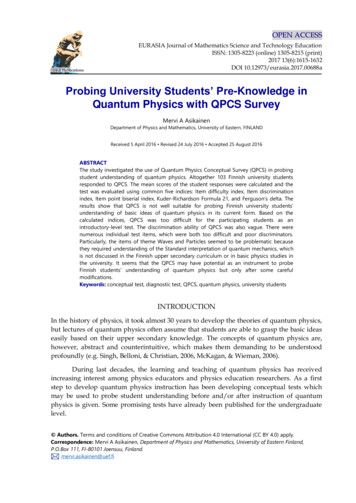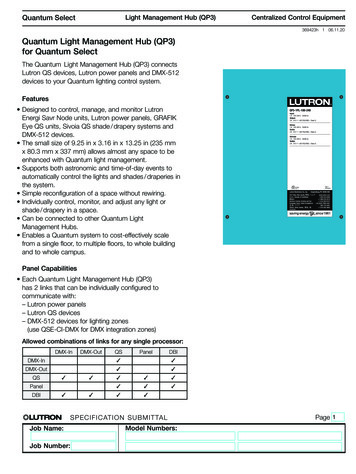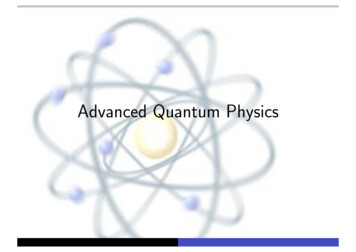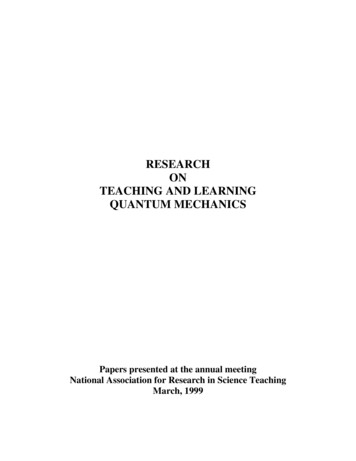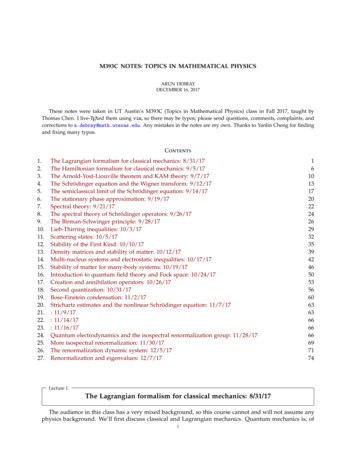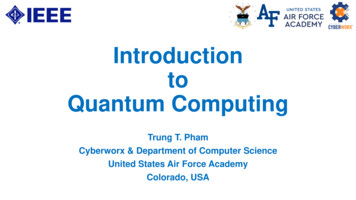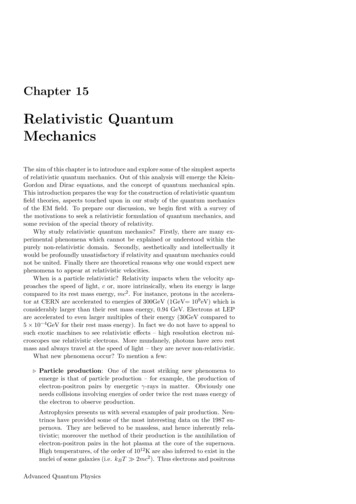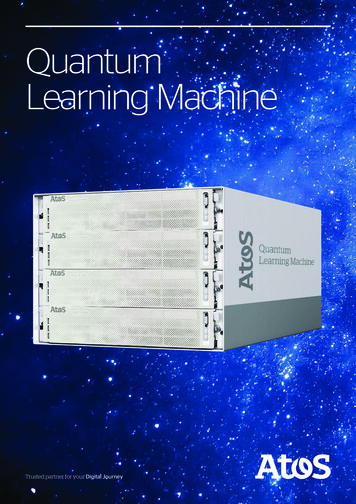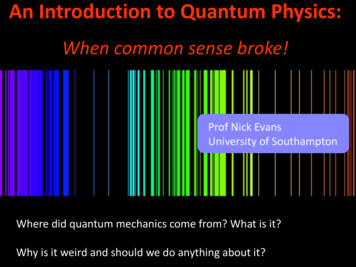
Transcription
An Introduction to Quantum Physics:When common sense broke!Prof Nick EvansUniversity of SouthamptonWhere did quantum mechanics come from? What is it?Why is it weird and should we do anything about it?
h dople use the trick of writing the solution like thisGGE ihen take either just the real or imaginary part.2 dtUUthat Wherein quantum mechanicswere we?p iach of the four0D5 -h dE electronsiLight andshow both particle and wave like properties.2 dtD3g2z is applied toyh d2 dxp !L tR hEp222h di2 dx M2h2 2d2dt2h22 2d2dx2 2 p2 EtRsinŪRh x L h ty LA operators”m (m 2)23!m 4
Square well solutions .We interpret the second plot as showing us the probability ofthe particle being at each point in space when we make anobservation .
Fermions vs BosonsWhy do some materials seem wave like (light)& others particle like (electrons)?We’ve come to learn that bosons can have any number ofquanta in a particular state so you can build up the wave For fermions there canonly be one quanta in agiven state so they alwayslook bitty
The Hydrogen AtomAn Introduction to Quantum MechanicsNick EvansAn Introduction to Quantum MechIntegrationQ2V (r) 4 0 r1 dr2 2r dr dr2dr anglesusntiationow, from first principles, thatQ6: There is another way to formulate mechanics thatis equivalent to Newton’s laws. One gives a particularnumber to any trajectory that a particle might travel by(here we really allow any motion to begin Integrationwith - speed isnot connectedto position!) - the path with the smallest2eQ6: There is anovalueV (r) of that number is the path taken. The way to defineis equivalent to N4 0 rthat works is through the Actionthe numbernumber to any traZ(here we really allS (T V )dt1 dr2 2r drd sin x cosCalculusxdxDi erentiationnd and identify the nature of the turning pointsNick Evans not connected todvalue of that numbr2 anglesdrT kinetic energy, V potential theenergynumber that wlet’s do a very simple one dimensional example whereT 1mẋ2 .2Write out the Action. Imagine that you expand the Tpaths kinetiQ1: Show, from first principles,thataround the true minimum32V V (x)
If you look for solutions for a negative charge in orbit around avery heavy positive charge you find these possible states:S 1P 3D 5F7
We beautifully explain the periodic tablepattern by stacking fermions in orbitals except we need an extra 2 folddegeneracy intrinsic spin Beautifully predicts the Balmer spectrum
and breath
Weird & Wonderful Quantum I
Wave Function CollapseOur quantum theory describes the evolution of Schroedinger’swave. perfectly sensibly .But when we do a measurement it describes the probability offinding a particle somewhere but how does nature decide?Don’t ask (CopenhagenInterpretation)All things happen in amultiverse (Many Worlds)We’re missing something(Hidden variables)
Schroedinger’s CatThe question becomes what is a measurement that collapsesthe wave function?You? Me? A Cat? An Atom?If a probabilistic quantumprocess controls a real lifeevent then a cat can become50% alive and 50% dead .In a quantum lottery every ticket wins in some part of the wavefunction (is that better?)
WeirdThe truly odd thing here is that no one has ever thought ofan experiment that probes this (and wow have peopletried!) or done an experiment where QM doesn’t work.When you do an experiment the wave function collapses andthe theory predicts the probabilities perfectly end of.
EntanglementAn atom can emit two photonsIt’s equally likely to swap the polarizations the photon is 50%spinning left, 50% spinning right an observer “collapses thewave function” to one or the other BUT when it does so the spin of the other guy is fixed also. thatcollapse has happened potentially very far away this leads tofaster than light “communication” Except that you can’t send information this way . So againnothing quite breaks
and breath
Damn Your Waves – Give Me Particles!Heisenberg’s Uncertainty PrincipleOr equallyxtp hE h
Feynman’s Sum Over HistoriesFeynman incorporated the Uncertainty Principle into adescription of classical particle paths The classical path becomessmeared by other paths that theUncertainty Principle allowsThese are very wild on short timescales but much less so over dayto day time intervals You can have multiple destination points also and then thetheory returns probabilities for the final position doh. Wavefunction collapse is back
DecoherenceThere is an understanding that larger systems become moreclassical – the DE you can borrow in some time gets spreadmore thinly between many particles in a system so each lies abit closer to a classical configuration This includes the idea of particles making constantmeasurements on each other and may explain why the largescale world looks rather classical It doesn’t solve the Schroedinger cat type set ups though!
and relax
Weird & Wonderful Quantum II
TunnellingApparently magic things can happen on short distance scalesdue to the wave nature of particles
0 19 J) pturningpoints ih dWrite2 dx out the Action. Imagineh thatd you expand the pathsWe’vep iaround the true minimum2 dxseendinger equationx xm xẋ ẋm ẋsolutions1 orderhe solutionsinfinitequantumsquarein a wellfor anWriteout theleadingchangemv 2 V E in the actionWe’veseensolutionsS. in freeẋ piece lookspace2omtheSchroedingerequationlawrceeachof followsthefourNow use Integration by Parts to make the 2 a term evaluated at the endsh2d2 like just x. hYoud will1 pgetV path. i We will assume4 V E these ends points areof theHz (2 )is appliedto2 In dx22 dt assumethe central regionV thatconstantwhich is greater2mheld fixed.s fromthan the E of the particle (classically it can’t pass)If we were at the minimum then the leading order S zero potential betweenx 0 and2 L - elseleaving the Cal- 0. Show thatthish conditionis equivalent1d2h d to Newton’sfinite. V isecond law.2m(2 )2 dx22 dtthe Calcium.endent solutions you can always find a soatomicorm structure22xcos x and. eu(x)ehe nth term ini2 E/h1 h d u 2m (2 )2 dx2(VE)ution for u(x) and then try a solution of thewithu(x) A sin kx B cos kxu Aepp2m(2 )/h VExIt’s anexponentialdecay but notzero
TunnellingThis is how radioactive alpha-decay happens .Protons wouldn’t fuse in the sun without tunnelling through theCoulomb repulsion . And its used by some electronics components now
An Introduction to Quantum Mechanics Nick Evans Classical Physics Q1: Show that the classical energy of an electron in a circular orbit in a hydrogen atom is given by E Q2 8 0 r The Semi-classical Period Q2: The photoelectric e ect is described by the key equation for the energy of the electron 1 2 m e v 2 e W f h
